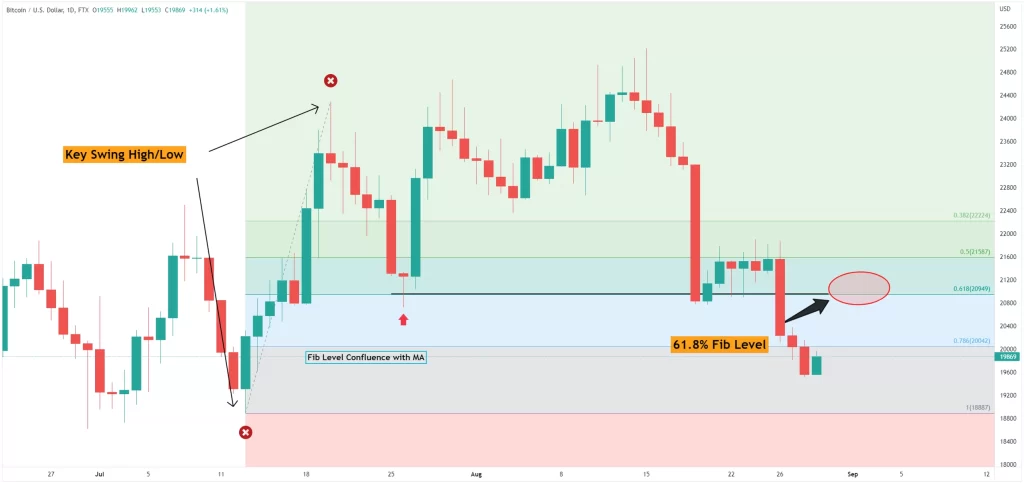Basics of Fibonacci Trading

Fibonacci Retracement is a popular tool used by traders to identify turning points in the prices of digital currencies. Without this tool, traders might enter the mysterious crypto market without confidence, risking significant losses.
While the fib Retracement tool is usually used in traditional stock or forex markets, you may be surprised to learn that it also works exceptionally well for cryptocurrency markets.
In this article, we aim to talk about trading with fibonacci retracement in crypto and decode its technical aspects by using some good examples of fibonacci levels. By the end, you’ll learn how to identify critical levels on trading charts using Fibonacci tools.
What are fibonacci retracement levels?
Fibonacci retracement levels are horizontal lines of support and resistance in the cryptocurrency market, including the ratios 23.6%, 38.2%, 61.8%, and 78.6%.
Fibonacci retracement comes from the Fibonacci sequence, which appears in nature and mathematics. This sequence of numbers was created by an Italian mathematician named Leonardo Fibonacci. Fibonacci retracement levels are used in analyzing cryptocurrency price charts to identify turning points.

Advantages and limitations of crypto fibonacci calculator
Advantages:
- Provides objective entry and exit points
- Can be applied to various timeframes and markets
- Popular among traders, potentially creating a self-fulfilling prophecy
Limitations:
- Not always accurate
- Should be used in conjunction with other forms of analysis
- Requires practice and experience to use effectively
What do fibonacci percentages represent?
Fibonacci retracement is expressed as a percentage and is applied to the previous trend. The Fibonacci retracement tool converts the percentage to the price of the chosen cryptocurrency, indicating where the market might move and potentially reverse trends.
To use fibonacci crypto chart in trading you must know the retracement leves. In general, there are four main retracement levels:
- 23.6%
- 38.2%
- 61.8% (the “golden ratio”)
- 78.6%
Fibonacci retracement percentages are derived from the Fibonacci sequence, which was discovered and shared by Leonardo of Pisa in his book Liber Abaci (The Book of Numbers) published in 1202.
The Fibonacci sequence is as follows
1, 1, 2, 3, 5, 8, 13, 21, 34, 55, 89, 144, 233, 377, 610 …
Each number in the sequence is the sum of the two preceding numbers.
For example, 21 divided by 34 equals 0.6176. Notice how the ratio of two adjacent numbers approaches 0.618 as the sequence extends. The ratio 0.618 is represented as 61.8%.
We can apply this method again by dividing each number by the one two places ahead.
Second Fibonacci retracement level
In the second example of fibonacci levels, 21 divided by 55 equals 0.3818. The ratio of every two numbers approaches 0.382, or 38.2%, which is the second key level.
Third Fibonacci retracement level
If we apply this method a third time by dividing each number by the one three places ahead, 21 divided by 89 equals 0.2360. As this sequence extends, the ratio moves toward 0.236, or 23.6%, which is the third retracement level.
The fourth and final level is 78.6% or 0.786.

An Example of calculating fibonacci retracement ratios
Let’s say an uptrend starts at $200 and rises to $300, increasing by $100.
The four ratios—23.6%, 38.2%, 61.8%, and 78.6%—are applied to the trend length, which is $100.
The first retracement level at 23.6% adjusts the highest price by $23.60 (uptrend of $100 x 23.6% = $23.60). $300 minus $23.60 equals $276.40.
The second retracement level at 38.2% adjusts $38.20 from the high of $300 ($100 uptrend x 38.2% = $38.20).
Calculations for the third and fourth levels are similar, using 61.8% and 78.6% as the factors.
After these calculations, we have four price areas where the downward correction may pause and then return to an uptrend. In the example above, the price temporarily pauses at the 38.2% level, then falls to the 61.8% level. Prices eventually stabilize and return to the 38.2% area.
Fortunately, indicators automatically solve these calculations and draw horizontal price zones on the chart. So all you need to do is learn how to use the Fibonacci retracement tool.
How to draw fibonacci retracement levels
Drawing Fibonacci retracement levels is simple with the help of tools, as explained below:
Identify the trend for drawing fibonacci retracement lines
- First, locate a completed trend where you want to apply the Fibonacci retracement.
- Find the charting tool called “Fibonacci Retracement.” This tool is available on many charting software platforms, including TradingView.
- Once the tool is activated, click the starting point of the trend.
- Make the second click at the end of the completed trend.
- Adjust the visible levels to 23.6%, 38.2%, 61.8%, and 78.6%.
- At this point, the Fibonacci retracement levels will appear on the chart. Traders focus on these levels to identify reversal points in future corrections.
Using the fibonacci retracement tool for trading cryptocurrencies
Using the Fibonacci retracement tool is relatively simple and can be effective when trading cryptocurrencies in an exchange platform.
- Step 1: First, locate a completed trend. This tool can be applied to both uptrends and downtrends and on all chart time frames.
- Step 2: Draw the Fibonacci retracement lines in the direction of the completed trend. For a completed uptrend, this means drawing the retracement from left to right in an upward direction. For a completed downtrend, draw the pattern from left to right, ending at the bottom of the trend.
- Step 3: Wait for the price to reverse near the four key levels. Focus on these key levels to predict price changes.
- Step 4: Enter the trade in the direction of the main trend. An uptrend retracement means prices are temporarily moving down. Then, aim to enter a long (upward) trade near one of the four key Fibonacci retracement levels. Some traders may rush to enter a position at a retracement level, while smart traders will wait for the price to react and break higher before entering for the long term.
Conclusion
The fib retracement tool is one of the most powerful tools in a trader’s toolbox. It can help you identify hidden support and resistance levels, allowing you to manage your trades with more skill. However, the tool is not without error and is more effective on cryptocurrencies with lower market value.
So, to use fib retracement:
- Identify a significant price move (uptrend or downtrend).
- Draw a line from the start of the move to the end.
- The tool will automatically generate horizontal lines at the key fibonacci levels
If you have any specific questions or need further details, feel free to ask!
More to read: